
19 Slices Of Raspberry Pi For Digital Signage
December 13, 2013 by Dave Haynes
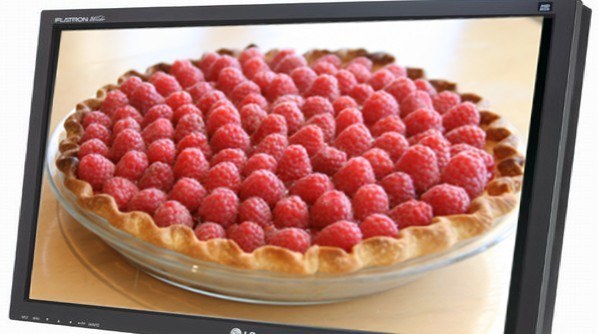
Posts about using the $35 Raspberry Pi for a digital signage project tend to generate a lot of reader interest, and some work I’ve been doing has required me to poke around a bit to see what all is out there.
Turns out there are many I didn’t know about. So here’s a round-up of options, in no real order, for the end of the market that either has very tight budgets or people behind them determined not to use fully commercial software and hardware options:
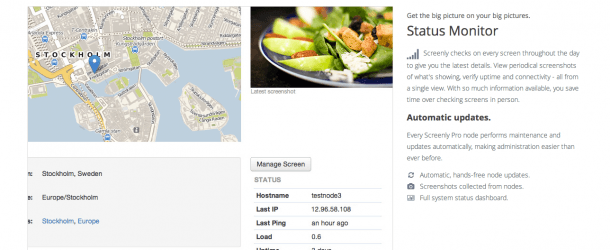
Screenly
WireLoad – which has developers in the UK and Sweden – says its Screenly content management service is free for open source developers and $10/month for a Pro version you don’t have to be a nerd to use. The tiny Raspberry Pi credit card-sized computers cost $35 at a base level, and once you deal with a memory card, HDMI cable, power adapter and a case you are at all of $60.
There is a full post on the product here: https://www.sixteen-nine.net/2013/05/03/screenly-serves-raspberry-pi-alternative-android-players/
Rise Vision

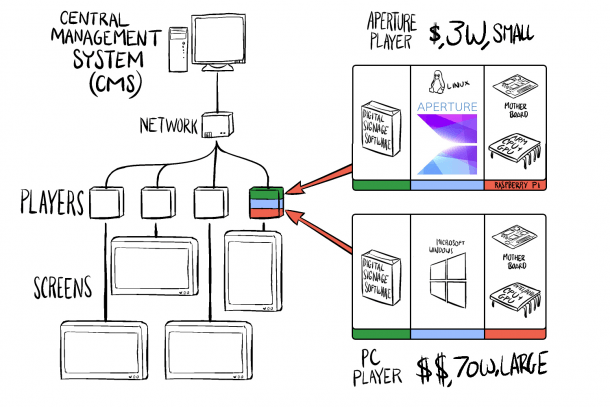
Aperture
One of my finer moments in my career came this summer, when I met Bryan Crotaz in the London offices of Silver Curve, and briefly nodded off as we chatted. It was the byproduct of getting zero sleep on a red-eye flight, not Bryan or his product.
His company has spent some two years developing a graphics engine that can take a little device like the Raspberry Pi and render lovely, crisp motion graphics and smooth video.
The product is called Aperture, and is described as a graphics engine for digital signage that enables software vendors to run their software on a mobile phone chip instead of a PC. So Aperture is not a CMS, but works with software platforms to let them use what they already have on something less costly than a regular PC, without compromise on visual quality.
Normal digital signage players run on a PC behind every screen. This expensive, energy intensive and old-fashioned practice means that digital signage is a costly solution for any company looking to modernise their advertising.
Aperture runs on mobile phone chips rather than PCs, which don’t get hot, use less power than an electric toothbrush, and provide the same quality as the PC they replace.
Full post here: https://www.sixteen-nine.net/2013/07/12/silver-curve-puts-light-aperture-digital-signage-engine-raspberry-pi/
Concerto

Concerto is a long-standing open source digital signage platform developed and managed by students at one of the better known and respected engineering schools in the US, Rensselaer Polytechnic Institute.
The project is the work of a skunkworks tech group associated with RPI’s Student Union, and has been in development for several years. Because it’s free and open, developers have been attracted to the software as a foundation for getting a signage project working with the Pis.
Here’s a Raspberry Pi forum that references Concerto and some GitHub projects.
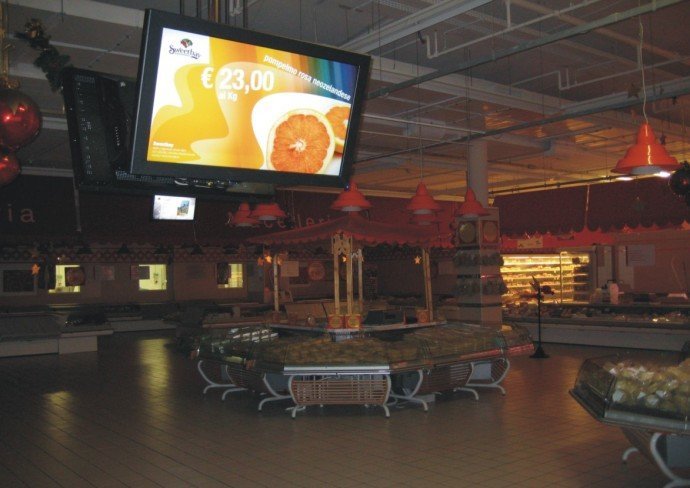
Raspberry Digital Signage
An Italian company has developed Raspberry Digital Signage, what it touts as the “best digital signage operating system for the Raspberry Pi.”
Raspberry Digital Signage is an operating system designed for digital signage installations on the Raspberry Pi, which can handle both web and multimedia content.
Web view displays HTML pages from an Internet or local area network resource; it has three different possible sub-views: you can choose between Mozilla Firefox experience, Google Chromium experience and the Midori experience; the last one also features Gnash support (Adobe Flash replacement): this is the only way to play Flash content on the Raspberry Pi.
Media view can display both a slideshow of images and a video player of Internet or local network files (http:// and https://).
Raspberry Digital Signage shows a full-screen view restricted to the web page or slideshow/video playlist specified; there is no way to escape this view but rebooting the machine. It is a hacker-proof secure operating systems for indoor and outdoor use. It is a port of Instant WebKiosk/Easy Digital Signage for PCs.
Interestingly, developer Marco Buratto is also raising money to build a different board with a quad core processor to run digital signage.
1080Dots
Dutch company 1080dots has a mainstream content management system and players for digital signage, but has been working on a version that uses ARM processors and would work with the Pi. Not much more available than that, but here’s a promo video:
Info-Beamer
German developer Florian Wesch has a product/project called Info-Beamer, and version that runs on Raspberry Pi. A propeller beanie will be helpful in reading his next bit:
info-beamer pi is a specially crafted version of info-beamer for the Raspberry PI. It is the most powerful digital signage player currently available for the Raspberry PI.
Hardware Accelerated: info-beamer pi is optimized for the PI. It uses hardware decoding for H.264 videos and JPEG files. The rendering is done in hardware using OpenGL ES 2.0.
Saves Energy: Running info-beamer pi 24×7 requires around 700mA (3.5 W). This translates to around 6€ per year.
Powered by Lua: There is almost no limit on what you can display. Everything can be customized using the Lua programming Language. Include realtime effects using accelerated GLSL shaders.
It looks like the sort of thing that would require some serious developer skills to use, and not something to hand to someone in marketing and say, “Here, get it working.”
There is a free version and tiers of commercial licensing.
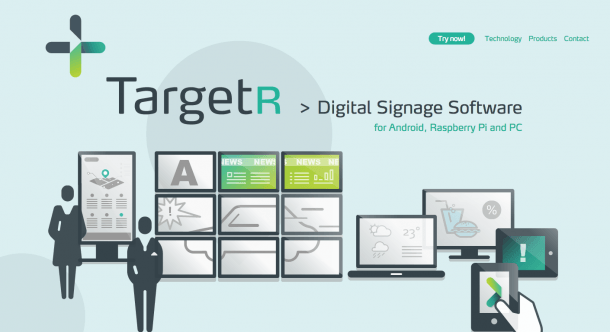
TargetR
Tonbridge, UK-based TargetR already had a nice product working with low-cost Android players. Now they have a Pi version in beta release.
Key Features: The TargetR Raspberry Pi Player uses the GPU to display full screen images and videos at up to 1080p at full speed. Using a custom Linux distribution the player auto starts when the Raspberry Pi is plugged in and automatically enters provisioning mode.
Reliability: The Raspberry Pi Player can handle network failure using locally cached content. The core player has built in safeguards to detect video or image playback errors.
Connectivity: The Raspberry Pi Player uses Ethernet or a Wi-Fi USB dongle to communicate with a TargetR server and CDNs. As the underlying operating system is a Linux based distribution, adding a simple caching proxy server configurations can be done both within the operating system or as part of the configuration of the player.
Remote Control: The Admin Interface allows you to monitor the status of devices running the player. A full health report is provided of of the device, allowing administers to diagnose issues and detect if a device is offline. Using the Admin Interface, the player can be configured to display image and video content based on advanced targeting.
PiCube by FirstView
Finnish software shop First Technology has had a digital signage offer on the market for almost 10 years, and now has a version working with the low-cost Pis.
The interesting spin here is that the company will give away the Raspberry Pi player and cables as part of the deal in activating a monthly content management account using the FirstView DMS platform.
Order one PiCube for each screen you wish to change into a digital signage channel. You can use the PiCube with any digital screen with a HDMI or DVI input. The PiCube is attached to the screen and to the network, and voila! A digital signage system is up and running! After plugging in the player you just log in via Internet to your FirstView Manager user account, and start adding images and videos to your screen(s)!
PiWall
Yes, there is a video wall management system using Raspberry Pis as the players.
The PiWall software package makes it possible to build video walls of arbitrary size by combining a collection of screens, adding one Pi per screen to drive the relevant portion of the wall, and a master Pi to rule them all. We have been busy packaging and documenting a free version of the code and have now made this available on the website along with instructions about how to build your own PiWall.
As a shining example of how loopy the digital signage market is, PiWall was developed by three engineers at a Nuclear Fusion research centre in the UK.
Here’s a demo video:
Tellystream
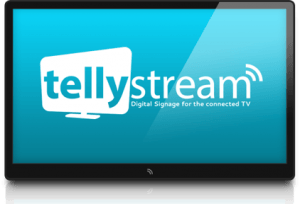
This is a streaming solution using XBMC and Pis.
Full post from earlier this week is here: https://www.sixteen-nine.net/2013/12/12/mash-up-from-oslo-uses-xbmc-and-raspberry-pi-to-make-digital-signage/
Pi Presents
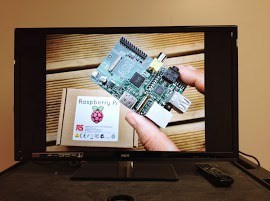
This is a home-brew software package developed by a retired programmer/farmer in the UK.
Pi Presents is a toolkit for producing interactive multimedia applications for museums, visitor centres, and more.
Says the developer: There are a number of Digital Signage solutions for the Raspberry Pi which are generally browser-based, limited to slideshows, non-interactive, and driven from a central server enabling the content to be modified frequently.
Pi Presents is different, it is stand alone, multi-media, highly interactive, diverse in it set of control paradigms – slideshow, cursor controlled menu, radio button, and hyperlinked show, and able to interface with users or machines over several types of interface. It is aimed primarly at curated applications in museums, science centres, and visitor centres.
Being so flexible Pi Presents needs to be configured for your application. This is achieved using a simple to use graphical editor and needs no Python programming. There are numerous tutorial examples and a comprehensive manual.
Solix DS
This Polish company has a Swiss Army Knife solution that seems to work on all kinds of devices, including Android units, Google TV and the Pi.
They say:
SOLIX DS is a web-based digital signage solution that makes it easy to control what is displayed on a remote screen. Multi-media content such as images and videos are added to a SOLIX DS channel and displayed full screen or embedded into a web page or application. Content can link to third party web pages making the platform ideal for advertising and engaging with customers.
Linutop
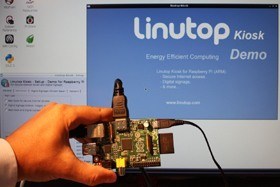
Add Linutop to the list of options for running digital signs using the teeny $435 Raspberry Pi micro-PC.
The French software company has made its Linutop Kiosk available for Raspberry Pi devices.
The software can handle secure Internet access Kiosks running HTML5 and digital signage systems using still images and MP4 video. The new version of the software also allows network remote controls for smartphones and tablets, as well as PCs.
All the details on how to use it are here ….
pisignage
An Indian company, Ariem Technologies, has launched a digital signage software solution that mashes up a couple of buzz heavy technologies – Google’s Chrome platform and the Raspberry Pi micro PC.

is a cloud-based Digital Signage Solution for Small Enterprises. The Signage Player is based on Raspberry Pi, an off-the-shelf credit-card sized Computer. The Cloud server comes with a simple Admin Panel, enabling you to deploy the solution in minutes. PiSignage on Chrome provides the same Signage Player features in a Chrome Application. By installing the app, you can experience the player functions in your PC/device and without the need for a Raspberry Pi.
To get started, you get an account, download the Chrome app and register it using a device ID displayed on the Pisignage website, then off you go.
The service is free for up to three players on a network. After that, you pay for more licenses and more storage.
I like that the platform is driven by HTML and lightweight code, and uses an HTML player that means while the product is position as a Pi thing, it can run on other devices with browsers.
UCVIEW
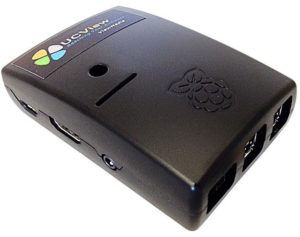
Most of the companies that have introduced digital signage solutions for Raspberry Pi have been start-ups or little teeny existing companies with no marketplace presence.
But now we have UCView, a long-running signage software company operating in greater LA, launching what’s called ARM Caster HD, which is powered by Raspberry Pi.
Says the company:
Known as one of the smallest media players available on the market; this portable credit-card sized player can accomplish a lot for its size. The media player not only has the ability of displaying full-scale digital signage for your audience on a daily basis, but is capable of engaging viewers with 1080p HD video. The new ARM Caster includes specifications such as 512MB RAM, an HDMI output, and newly added four USB ports for easy set up and connection.
The slim and portable ARM Caster offers a lot of benefits as shown below:
- The ARM Caster, powered by Raspberry Pi, is the length of a credit card. The small device is practical enough to carry around and can easily be concealed away from view of your target audience.
- ARM Caster HD offers superior 1080p HD playback which can be used to entertain people of all ages.
- Despite its small size, the ARM Caster will not overheat. The product has been rigorously tested and can flawlessly run for days without having any complications.
- The Raspberry powered device comes with a well-built and solid case. It’s tough enough to handle various conditions without failing.
- The media player provides quiet operation. It doesn’t make any noise, allowing for you to work in peace.
The product is aimed at small businesses, as you might expect.
UPDATED – APRIL 2016 – UC View has launched a new hardware player, called the ARM Caster HD, that’s running off the new Raspberry Pi 3.
The Raspberry Pi 3, says UC View on its company blog, “is an exceptional solution for those who want to run a small-scale digital signage network without having to pay a high price. This mini form-factor player is packed with cutting-edge components allowing for full-fledged functionality and a hassle free setup process. The ARM Caster HD, powered by Raspberry Pi 3, has up to 10 times the performance as its predecessor the Raspberry Pi 1. This unit runs with a 1.2GHz 64-bit quad cord ARM Cortex-A53 CPU, allowing for fast connection and powerful computing performance.”
_______________________________
Saba Technosoft
Mumbai-based Saba Technosoft markets the SABA DSS package for remotely managing and controlling digital signage systems content. The software system contains management and player modules, and runs across multiple player types including Raspberry Pi.
_______________________________
OOZO TV
Sao Paulo, Brazil-based start-up OOZO TV is marketing a digital signage solution built around social media and ultra low-cost Raspberry Pi 3-driven media players.
The company is touting what it calls a hyperlocal custom content solution that draws much of its content from real-time feeds from social media networks like Instagram.
There are three pricing plans – from free (with limited capabilities) to a $129 USD/month per player arrangement that gives users multiple social media profiles and hashtags to query and display, filtering tools, high frequency updates, support and various other things. The $129 includes the Pi 3 box, but $129 may well be more than the one-time capital cost of the unit.
_______________________________
NEC
The European business wing of Japanese panel maker NEC has bucked the trend towards ARM-based System on Chip smart displays among its competitors, and instead released a new display line that includes slot-loaded media players based on the Raspberry Pi board.
That’s what I know about. Have your own project, or know of one I missed? Please add to the comments!



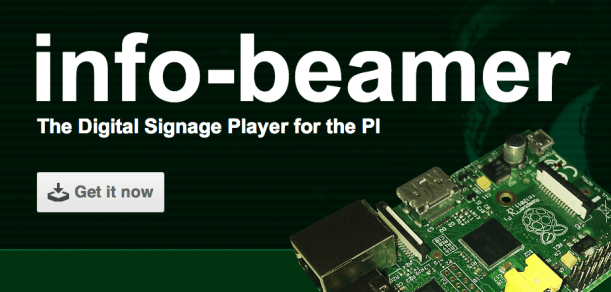
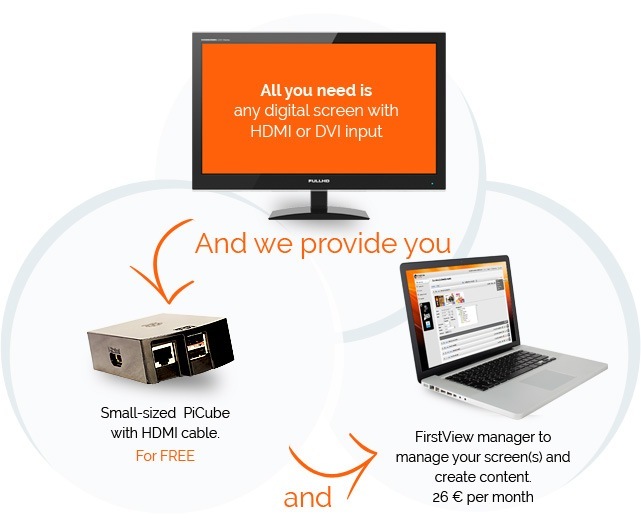

Leave a comment